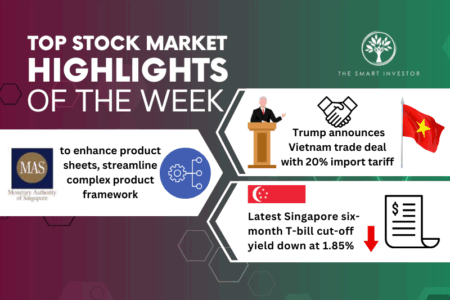For new investors who are just starting, the stock market can seem like a daunting place.
Hence, it pays to read up extensively on businesses and how the market works before plunging ahead with your first stock purchase.
Investing is more than just about analysing financial numbers or understanding how businesses and industries work.
At the heart of it, investing involves the allocation of your hard-earned money with the hope of growing it into a larger pot or receiving a stream of dividends.
And when your money is at stake, your emotions will undoubtedly be tied in with your investments.
Here are five psychological biases you need to be aware of to ensure they do not trip up your investment process.
1. Overconfidence
Overconfidence should probably be described as the “mother of all biases” because it affects a large swath of investors.
This bias describes how many investors overestimate their abilities at either predicting market direction or forecasting corporate earnings.
As a result, these investors place bets based on their inflated egos rather than relying on hard, objective evidence.
For a start, an investor does not need to predict the direction of the stock market to do well.
There is even less of a need to estimate corporate earnings as this is exactly what Wall Street loves doing, and you should not participate in their games.
Overconfidence is the bane of investors because it makes you gloss over important facts and act on your “gut feel”.
Investors who act on their overconfidence may bet the house on a risky stock that has lots of potential, but then later collapses.
Hence, this bias can end up costing you an arm and a leg.
There is a simple way to mitigate overconfidence when you invest.
Stay grounded and always check and rely on the facts when investing.
Better still, keep a simple diary of your thought process to justify every decision and back this up with facts and figures.
The idea is to tame your overconfident side and temper it with realism so that your investments do not go off-tangent.
2. Hindsight Bias
Hindsight bias makes our minds think that we know what is going to happen after the event has occurred.
It is a sneaky bias because it creeps up on you without you realising it and leads to the first bias – overconfidence.
Human beings find it tough to deal with uncertainty but this is what investors face daily in the stock market.
Numerous macroeconomic events such as interest rate changes, jobs data, GDP data, and inflation data may impact share prices.
Investors who are guilty of hindsight bias assume they knew what numbers would be released and how stocks would react, making them feel like geniuses.
The risk here is when you buy or sell stocks by presuming that you can predict such events with accuracy.
The same solution applies – write down your thoughts before any major economic statistics release or earnings report.
Check back later to determine how accurate you were.
Chances are you would have got it wrong more often than right, thereby convincing you that you do not have the divine ability to predict the future.
3. Confirmation Bias
A close cousin of hindsight bias is confirmation bias, which is to seek out information that conforms to your beliefs and reject information that does not.
Confirmation bias is dangerous because it blinds investors to potential negative aspects of an investment as they continue to seek out positive traits.
It may be tough to identify confirmation bias when you invest because your mind unconsciously rejects data and information that disagrees with your opinions.
As an example, social media helps to exacerbate confirmation bias by letting you see what you prefer and filtering out anything that you find undesirable.
It’s helpful to find a trusted friend who can act as a counterbalance to your ideas and provide you with an alternative view.
By challenging your assumptions and pointing out the less-rosy characteristics of an investment, you can then get a more objective, all-rounded view.
This type of holistic thinking helps you avoid painful investment decisions that ultimately lose you money just because you may have been blinded by the good while ignoring the bad.
4. Endowment Effect
The endowment effect makes you believe that what you own is worth more than something you do not.
Applied to investing, it means that you believe the stock that you own should be worth more without good reasons to support this belief.
A person who does not own the same stock may only be willing to pay a much lower price.
This scenario sets up unrealistic expectations when investors demand higher prices to sell stocks they own that are not justified by their earnings or prospects.
To mitigate this, be realistic in assessing the business you own by studying the historical valuation of the stock.
Remember that the stock does NOT know that you own it, so ascribing a higher value to it just because it is in your portfolio does not make much sense.
Instead, learn about average valuations and try to discover if the business may have attributes that give it an edge over its competition.
Only then will it be reasonable to assume that it should trade at higher valuations than its peers.
5. Recency Bias
The final bias is recency bias, which describes how our investment decisions may be influenced by recent events.
For example, if a devastating market crash just occurred, it may scare many investors and prevent them from deploying their funds to capture attractive opportunities.
Another example is the release of positive earnings that causes a company’s share price to soar, causing investors to pile in to “chase” the share price.
In both cases, it will be wise for you to check the long-term frequency of market crashes and evaluate the prospects of the company before making any investment decisions.
When your mind is affected by recent events, you tend to extrapolate them out into the future and assume things will always stay the same.
Although crashes are a normal aspect of markets, investors should realise that over the long term, markets will trend upwards.
As for corporate earnings, it pays to research if the company can continue its winning streak or if it may just be a one-trick pony.
Being cognizant of recency bias helps you to avoid making snap decisions based purely on recent information and lets you take a step back to evaluate the big picture.
This could be the fastest way to jump from a “newbie” investor to a seasoned pro. Our beginner’s guide shows everything you need to know to buy your first stock and beyond. Click here to download it for free today.
Follow us on Facebook and Telegram for the latest investing news and analyses!
Disclosure: Royston Yang does not own shares in any of the companies mentioned.





